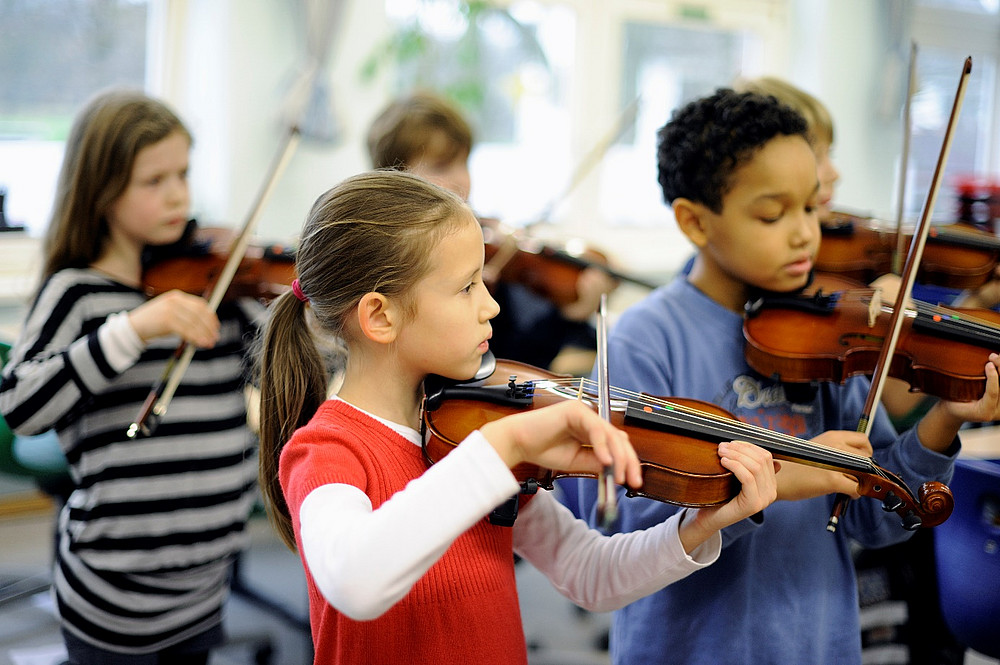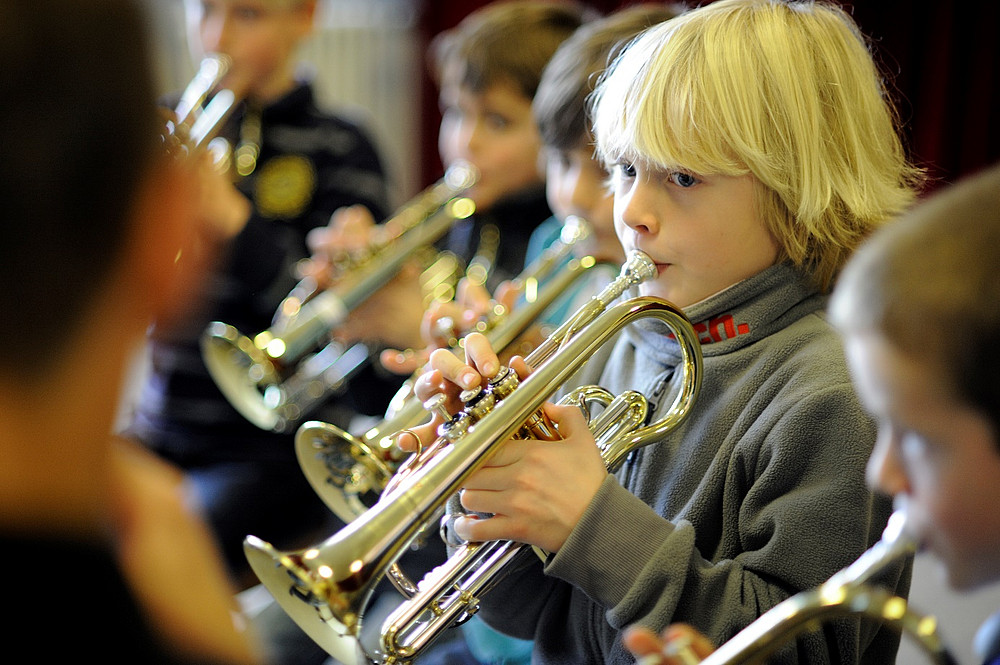Development of auditory and musical skills from a lifelong perspective
Active music-making requires the interaction of numerous brain functions.

Active music-making requires the interaction of numerous brain functions. These involve not only elementary auditory perception, but also spatial, tonal and temporal pattern recognition processes, reading music and the associated planning of movement sequences, as well as emotional and cognitive evaluation processes. Playing or singing in an orchestra or band requires close listening to others and also to oneself. Free improvisation also requires the ability to react directly to the expression of fellow musicians and to communicate with them. It is therefore plausible that singing and playing musical instruments also trains a range of other skills, which should lead to corresponding neuroplastic changes in the brain.
Despite public interest in the question of how singing and playing music affect the brain and behavior of children and adolescents, relatively little is known from a neuroscientific perspective about the interplay between talent, biological maturation processes and learning-related plasticity through musical training. This is due to the fact that there have been numerous cross-sectional studies with only one measurement point and some longitudinal studies over a period of a few years, but no studies over the entire course of development.
AMseL study
Our AMseL study ("Audio- und Neuroplastizität des Musikalischen Lernens"; Head: Peter Schneider & Annemarie Seither-Preisler; duration 2009-2021) is the first systematic longitudinal study on the development of human auditory processing from primary school age (7-8 years) to young adulthood (18-19 years).AMseL was carried out as a joint project in cooperation between the universities of Heidelberg and Graz and was part of the accompanying research funded by the German BMBF for the cultural education program JeKi ("Jedem Kind ein Instrument") running in NRW and Hamburg. The long-term study was later funded by the DFG, which enabled a total research period of 12 years with 5 measurement points. In the meantime, the former Heidelberg working group "Music and Brain" has become part of the Graz research area "Music Psychology and Brain Research" with several employees (Peter Schneider, Bettina Zeidler, Markus Christiner).
In the AMseL study, neuroanatomical, neurofunctional and behavioral methods were combined, with structural and functional magnetic resonance imaging (MRI, fMRI) and magnetoencephalography (MEG) being used as neurological methods. In addition, psychoacoustic test batteries - largely developed in-house - were used (Schneider et al., 2005; Seither-Preisler et al., 2007; Schneider & Seither-Preisler, 2023). These included tests to distinguish elementary sound characteristics, complex pattern recognition and melody and rhythm perception. In addition, questionnaires on the social and school environment were given and psychological tests on attention, phonological awareness and reading and spelling skills were carried out.
A total of 220 test subjects took part in the study, around half of whom were affected by learning and developmental disorders (LRS, ADHD, ADD). The majority of the test subjects completed all 5 measurement points.
We found clear individual differences in the shape and size of the auditory cortex (especially the Heschl's cross-windings / HGs) already at an early age (7-8 years) at the beginning of formal musical and school lessons. These differences remained stable over the entire study period regardless of musical training. Interestingly, the volumes of gray matter in the right HG predicted relatively well whether the subjects would invest no, little or a lot of time in instrumental playing in the following years. This suggests that this characteristic is a neuroanatomical marker of musical talent. In addition, we observed a continuous increase in white matter in the auditory areas of both hemispheres with increasing age, independent of musical practice. This biological maturation process is characterized by a growing neuronal networking of the auditory areas with other brain regions. In other words, our hearing is not fully developed at birth or in early childhood; it continues to develop. It has been shown that primary areas, which are responsible for elementary processing, are already fully mature at puberty, while secondary areas, which are important for auditory attention and pattern recognition, continue to develop into adulthood.

There were also plastic changes in brain activation (auditory evoked responses P1-N1-P2). The older the subjects got and the more they had played music before, the faster their brains reacted to musical sounds and the higher the synchronization between the right and left hemispheres. In addition, at the end of the study, only many music-makers showed a pronounced P2 component as a marker of attentive, consciously controlled auditory perception. In addition to these neurological indications, it was also shown at the behavioral level that musical training has a positive influence on the ability to distinguish elementary sound characteristics (frequency, tone duration, tone onset) and pattern recognition processes (rhythm perception and subjective pitch recognition). It follows that early musical training substantially promotes the development of auditory functions from childhood to young adulthood.
The observed interplay of "nature" (stable biological dispositions and natural maturational development) and "nurture" (learning-induced plasticity) was summarized by us in a neuropsychological developmental model of human hearing (Schneider et al., 2023). The model has many implications for future hearing and music therapy applications, for pedagogy and for educational policy discussions on the importance of early music education in kindergartens and music lessons in schools.
In this context, we also provide scientific advice on the musical language development program “Bakabu der Ohrwurm”. This was developed jointly by linguists and composers and is running in numerous Austrian kindergartens. The aim of the program is to learn German in a playful way through singing and movement. The program has already benefited ~350,000 children with both German as their mother tongue and a migrant background. A children's program of the same name has also been running on ORF since October 2022.
Interview with Annemarie Seither-Preisler on the Australian state news channel ABC News on 23.08.2023 on the results of the AMseL long-term study.
References
Schneider, P., Engelmann, D., Groß, C., Bernhofs, V., Hofmann, E., Christiner, M., […] & Seither-Preisler, A. (2023). Neuroanatomical Disposition, Natural Development, and Training-Induced Plasticity of the Human Auditory System from Childhood to Adulthood: A 12-Year Study in Musicians and Nonmusicians. Journal of Neuroscience, 43(37), 6430-6446.
Seither-Preisler, A., Parncutt, R., & Schneider, P. (2014). Size and synchronization of auditory cortex promotes musical, literacy, and attentional skills in children. Journal of Neuroscience, 34(33), 10937-10949.
Seither-Preisler, A., Johnson, L., Krumbholz, K., Nobbe, A., Patterson, R., Seither, S., & Lütkenhöner, B. (2007). Tone sequences with conflicting fundamental pitch and timbre changes are heard differently by musicians and nonmusicians. Journal of Experimental Psychology: Human Perception and Performance, 33(3), 743. https://dx.doi.org/10.1037/0096-1523.33.3.743
Schneider, P., Sluming, V., Roberts, N., Scherg, M., Goebel, R., Specht, H. J., […] & Rupp, A. (2005). Structural and functional asymmetry of lateral Heschl's gyrus reflects pitch perception preference. Nature neuroscience, 8(9), 1241-1247. https://doi.org/10.1038/nn1530